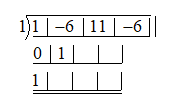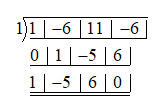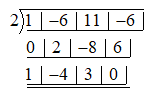
Verify whether the indicated numbers are the zeros of the given polynomial
$p\left( x \right)={{x}^{3}}-6{{x}^{2}}+11x-6,x=1,2,3$
Answer
588.3k+ views
Hint: Recall the definition of a zero of a polynomial. If ${{x}_{0}}$is a zero of a polynomial p(x), then we have $p\left( {{x}_{0}} \right)=0$. Hence determine at which point p(x) vanishes. Those points are the roots of p(x).
Complete step-by-step answer:
Alternatively, use synthetic division to determine whether the given points are the roots of the polynomial or not.
We know that if ${{x}_{0}}$ is a root of a polynomial p(x), then we have $p\left( {{x}_{0}} \right)=0$.
Checking x = 1
We have $p\left( x \right)={{x}^{3}}-6{{x}^{2}}+11x-6$
Substituting x = 1 in the p(x), we get
$p\left( 1 \right)={{1}^{3}}-6{{\left( 1 \right)}^{2}}+11-6=1-6+11-6=0$
Since p(1) = 0, we have x = 1 is a zero of the polynomial p(x)
Checking x =2
We have $p\left( x \right)={{x}^{3}}-6{{x}^{2}}+11x-6$
Substituting x = 2 in the p(x), we get
$p\left( 2 \right)={{2}^{3}}-6{{\left( 2 \right)}^{2}}+11\times 2-6=8-24+22-6=0$
Since p(2) = 0, we have x = 2 is a zero of the polynomial p(x)
Checking x= 3
We have $p\left( x \right)={{x}^{3}}-6{{x}^{2}}+11x-6$
Substituting x = 3 in the p(x), we get
$p\left( 3 \right)={{3}^{3}}-6{{\left( 3 \right)}^{2}}+11\times 3-6=27-54+33-6=0$
Since p(3) = 0, we have x = 3 is a zero of the polynomial p(x).
Hence x = 1,2,3 are the zeros of the given polynomial p(x).
Note: Alternative method: Synthetic division: Best method.
In this method, we start by writing coefficients of the polynomial in order from the highest degree to the constant term. If in between some degree terms are missing we set their coefficient as 0.
Hence $p\left( x \right)={{x}^{3}}-6{{x}^{2}}+11-6$ will be written as shown below

Now the point which has to be substituted(say x= 1) is written as follows

0 is placed below the first term

Now the terms under the same column are added. The sum is then multiplied with the root, and the product is written under the coefficient of the next term.
Hence, we have

Continuing in this way we have the following

Since the last sum is 0, we have $p\left( 1 \right)=0$. This method also tells you what the quotient will be when p(x) is divided by x-1. Here it will be $1\left( {{x}^{2}} \right)-5\left( x \right)+6={{x}^{2}}-5x+6$
Similarly creating tables for x = 2 and x = 3, we get

Since the last sum is 0, we have $p\left( 2 \right)=0$

Since the last sum is 0, we have $p\left( 3 \right)=0$
Hence x =1,2,3 are the roots of the given polynomial.
Complete step-by-step answer:
Alternatively, use synthetic division to determine whether the given points are the roots of the polynomial or not.
We know that if ${{x}_{0}}$ is a root of a polynomial p(x), then we have $p\left( {{x}_{0}} \right)=0$.
Checking x = 1
We have $p\left( x \right)={{x}^{3}}-6{{x}^{2}}+11x-6$
Substituting x = 1 in the p(x), we get
$p\left( 1 \right)={{1}^{3}}-6{{\left( 1 \right)}^{2}}+11-6=1-6+11-6=0$
Since p(1) = 0, we have x = 1 is a zero of the polynomial p(x)
Checking x =2
We have $p\left( x \right)={{x}^{3}}-6{{x}^{2}}+11x-6$
Substituting x = 2 in the p(x), we get
$p\left( 2 \right)={{2}^{3}}-6{{\left( 2 \right)}^{2}}+11\times 2-6=8-24+22-6=0$
Since p(2) = 0, we have x = 2 is a zero of the polynomial p(x)
Checking x= 3
We have $p\left( x \right)={{x}^{3}}-6{{x}^{2}}+11x-6$
Substituting x = 3 in the p(x), we get
$p\left( 3 \right)={{3}^{3}}-6{{\left( 3 \right)}^{2}}+11\times 3-6=27-54+33-6=0$
Since p(3) = 0, we have x = 3 is a zero of the polynomial p(x).
Hence x = 1,2,3 are the zeros of the given polynomial p(x).
Note: Alternative method: Synthetic division: Best method.
In this method, we start by writing coefficients of the polynomial in order from the highest degree to the constant term. If in between some degree terms are missing we set their coefficient as 0.
Hence $p\left( x \right)={{x}^{3}}-6{{x}^{2}}+11-6$ will be written as shown below

Now the point which has to be substituted(say x= 1) is written as follows

0 is placed below the first term

Now the terms under the same column are added. The sum is then multiplied with the root, and the product is written under the coefficient of the next term.
Hence, we have

Continuing in this way we have the following

Since the last sum is 0, we have $p\left( 1 \right)=0$. This method also tells you what the quotient will be when p(x) is divided by x-1. Here it will be $1\left( {{x}^{2}} \right)-5\left( x \right)+6={{x}^{2}}-5x+6$
Similarly creating tables for x = 2 and x = 3, we get

Since the last sum is 0, we have $p\left( 2 \right)=0$

Since the last sum is 0, we have $p\left( 3 \right)=0$
Hence x =1,2,3 are the roots of the given polynomial.
Recently Updated Pages
Two men on either side of the cliff 90m height observe class 10 maths CBSE

What happens to glucose which enters nephron along class 10 biology CBSE

Cutting of the Chinese melon means A The business and class 10 social science CBSE

Write a dialogue with at least ten utterances between class 10 english CBSE

Show an aquatic food chain using the following organisms class 10 biology CBSE

A circle is inscribed in an equilateral triangle and class 10 maths CBSE

Trending doubts
Why is there a time difference of about 5 hours between class 10 social science CBSE

Write a letter to the principal requesting him to grant class 10 english CBSE

What is the median of the first 10 natural numbers class 10 maths CBSE

The Equation xxx + 2 is Satisfied when x is Equal to Class 10 Maths

Which of the following does not have a fundamental class 10 physics CBSE

State and prove converse of BPT Basic Proportionality class 10 maths CBSE




